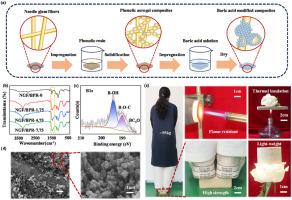In-situ constructuring boron-modified phenolic aerogels with enhanced mechanical performance and flame retardancy
IF 7.7
2区 材料科学
Q1 MATERIALS SCIENCE, COMPOSITES
引用次数: 0
Abstract
Phenolic aerogels are widely used in aerospace applications owing to their inherent flame retardancy, which exceeds that of combustible organic aerogels. However, these materials remain susceptible to smoldering even after being removed from an open flame, due to oxygen diffusion through their porous carbon structure, sustaining internal exothermic reactions. To mitigate the effects of their smoldering combustion, this study focuses on boron modification of the surface of phenolic aerogels’s porous framework. The results show that the material's limiting oxygen index (LOI) increased from 26.9 % to 29.9 %, while its peak heat release rate (pkHRR) decreased by 20.07 % in cone calorimetry tests. Moreover, total smoke production (TSP) dropped by 69.72 %, demonstrating significantly improved flame retardant properties. The materials demonstrated excellent mechanical properties, with tensile, flexural, and compressive strengths of 14.70 MPa, 23.49 MPa, and 7.15 MPa, respectively. This study presents a novel approach to developing phenolic aerogel composites that combine high flame retardancy, superior mechanical performance, and effective thermal insulation, showing great potential for building fire protection and aerospace applications.

具有增强力学性能和阻燃性能的原位结构硼改性酚醛气凝胶
酚醛气凝胶具有比可燃有机气凝胶更强的阻燃性,在航空航天领域得到了广泛的应用。然而,由于氧气通过多孔碳结构扩散,维持内部放热反应,即使从明火中取出,这些材料仍然容易阴燃。为了减轻其阴燃的影响,本研究着重于硼改性酚醛气凝胶的多孔框架表面。结果表明,该材料的极限氧指数(LOI)由26.9%提高到29.9%,峰值放热率(pkHRR)下降了20.07%。总产烟量(TSP)降低了69.72%,阻燃性能得到显著改善。材料的拉伸、弯曲和抗压强度分别为14.70 MPa、23.49 MPa和7.15 MPa,力学性能优异。本研究提出了一种开发酚醛气凝胶复合材料的新方法,该复合材料具有高阻燃性、优异的机械性能和有效的隔热性能,在建筑防火和航空航天领域具有很大的应用潜力。
本文章由计算机程序翻译,如有差异,请以英文原文为准。
求助全文
约1分钟内获得全文
求助全文
来源期刊

Composites Communications
Materials Science-Ceramics and Composites
CiteScore
12.10
自引率
10.00%
发文量
340
审稿时长
36 days
期刊介绍:
Composites Communications (Compos. Commun.) is a peer-reviewed journal publishing short communications and letters on the latest advances in composites science and technology. With a rapid review and publication process, its goal is to disseminate new knowledge promptly within the composites community. The journal welcomes manuscripts presenting creative concepts and new findings in design, state-of-the-art approaches in processing, synthesis, characterization, and mechanics modeling. In addition to traditional fiber-/particulate-reinforced engineering composites, it encourages submissions on composites with exceptional physical, mechanical, and fracture properties, as well as those with unique functions and significant application potential. This includes biomimetic and bio-inspired composites for biomedical applications, functional nano-composites for thermal management and energy applications, and composites designed for extreme service environments.
 求助内容:
求助内容: 应助结果提醒方式:
应助结果提醒方式:


